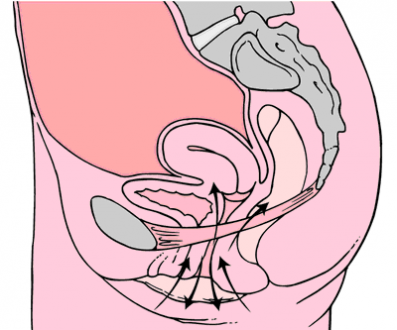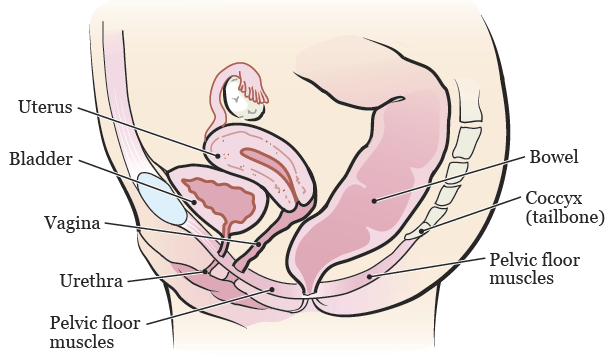Originally published by The Belle Method in The Purple Fig and The Huffington Post
We Pilates teachers love to talk about kegels. Like, all the time. Not just in class but at dinner parties, too (well, maybe that’s just me). It’s for good reason: engaging your kegels works your pelvic floor. The pelvic floor muscles are a group of muscles that attach to the front, back and sides of the bottom of the pelvis. They are like a hammock or a sling, and they support the bladder, uterus, prostate and rectum. They also wrap around your urethra, rectum, and vagina.

A strong pelvic floor keeps you from leaking urine, holds your internal organs in place, supports your spine and pelvis and is needed for sexual function. Yes to strong pelvic floors, please! So many of us have been taught to dutifully “do our kegels,” especially after giving birth to make sure things stay where they belong and sex stays enjoyable. When you’re hypotonic (weak) in that area, kegels done correctly are fantastic.
But what if your pelvic floor is too tense, or “hypertonic.” Basically that means it is constantly contracted (think of your shoulders hiked up to your ears when you’re stressed…now picture that happening down there). Doing kegels in that situation would be like trying to hike those shoulders up even higher; NOT a good solution to decreasing tension and improving muscle function.
Symptoms of a hypertonic pelvic floor include:
- Urinary frequency, urgency, hesitancy, stopping and starting of the urine stream, painful urination, or incomplete emptying
- Constipation, straining, pain during or after bowel movements
- Unexplained pain in your low back, pelvic region, hips, genital area, or rectum
- Pain during or after intercourse, generalized vulvar burning, inability to orgasm, throbbing, spasm, “pressure in the vagina”
The troubling thing is that so many women suffer silently with undiagnosed hypertonic pelvic floors. Many are doing exercise that is making them worse. Kegels are so often recommended to post-partum women, but how they are performed is almost never assessed in North America. Dr. Arnold Kegel started teaching pelvic floor contraction exercises in the 1940s by using internal palpation to cue the proper muscles. Somehow we’ve stepped away from that and kegels have become something women told to do without any real instruction other than “hold your pee.”
By contrast, in France every woman is offered six pelvic floor physiotherapy appointments after giving birth to prevent pelvic floor dysfunction. This is the way it should be! Let this be a public service announcement for the benefits of Pelvic Floor Physiotherapy. Just go get yourself checked, even if you haven’t had children.
So what causes a hypertonic pelvic floor?
Chronic stress: Tension patterns in the pelvic floor used to be unequivocally linked to sexual (or other types) of abuse. However researchers are finding that the vagina automatically fires (tenses up) in almost any type of stressful situation. The vagina does this to protect the incredibly precious goods inside and this is a direct reflection of the fight or flight response.
Physical trauma: Constant physical stress (load bearing), repetitive pressures running, cycling, jumping can all cause an overworked hypertonic pelvic floor.
Tummy Sucking: Many of us have replaced deep, abdominal activity with “sucking our stomach in,” and think we are constantly using our muscles. In reality, the sucking in motion is a pressure that pulls the abdomen’s contents up (not in). You get a temporary flat stomach that looks fantastic on the beach, but you also get a tucked pelvis, no butt muscles used when walking, no real core engagement, and excessive friction in the lumbar spine, hips and knees…and a hypertonic pelvic floor.
So what’s a gal to do? First of all, get checked out by a physiotherapist to understand how your floor is functioning. The truth is, most of us only do kegels halfway (read: incorrectly). The “hold your pee mid flow” analogy we’ve been taught is crap. All you’re doing is lifting up, working in one direction. You need to practice “letting go” just as much as lifting. You need to do it full range! Any anyone who is hypertonic should just be practicing “letting go” and omitting the lift entirely.
And finally, another reason to perfect your pelvic floor muscle function is because properly contracting and releasing that area connects to your deepest layer of abdominal muscles…which means truly flat strong lower abs! Can I get a “hell yeah!”
Knowledge IS power ladies!

You’re amazing, Nikki! Truly a gift to women’s health. Thank you for ALL the hard work you do to help women and Moms. Incredible.
That means a lot to hear, thank you Lesley!